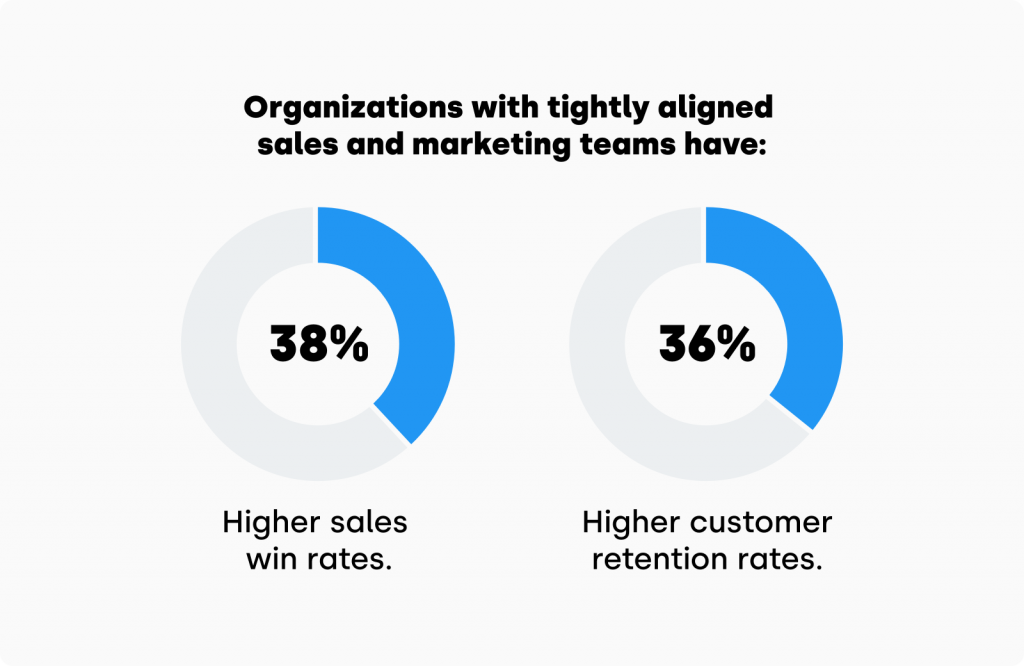How to align marketing and sales teams

It might be tough to pinpoint the exact reason, but the misalignment between sales and marketing is more common than you think. These teams tend to work separately, and both of them suffer as a result. Sales and marketing alignment can reap a great many benefits for your company — and increasing the productivity of both teams is just one of them.
So, why is it important to keep your sales and marketing teams aligned, and how can you achieve that goal?
Learn how to fix a broken team
Why should you align marketing and sales?
With consumers growing more demanding by the day and the vast majority of purchase processes taking place online in real time, it’s more important than ever to facilitate seamless collaboration between marketing and sales teams.
Many buyers do their research before deciding to purchase anything, and many of them claim that going online and researching a product on their own is far better than interacting with a salesperson.
This is where a marketing team can come in and increase the likelihood of conversion by providing key insights into what the buyer is actually looking for in a product.
When both teams work together they can easily figure out what topics are important for the potential buyers, and what questions should be answered to facilitate the purchasing process.
Working together, your sales and marketing teams can identify those topics that are most important to potential buyers, and those questions that need to be answered at each step of the purchasing process.
This kind of collaboration can facilitate lead generation, too.
Sales specialists are experts at judging which leads are most likely to turn into customers, and which leads are not really worth the effort. If they share this knowledge with marketers, your business is more likely to generate highly qualified leads in the long run. One of the great examples is promoting marketing activities on social media platforms, especially on instagram – where the marketing team has goals of increasing instagram followers, boost engagement, and generate leads. Whereas, for sales people it becomes a qualified lead generator to convert those leads into customers.
At the end of the day, marketers are only successful if salespeople are, and vice versa. The efforts of both teams are intertwined, which is why they both need to be on the same page.
This, however, won’t happen if they don’t have the right attitude and dedicated tools at their disposal. Once they are able (and willing) to work together, the results can be mind-blowing.
What is sales and marketing alignment?
First, let’s look at what exactly it means to align the sales and marketing areas of your business. Since both areas focus on developing relationships with customers, attracting new ones, boosting sales and, in the end, ensuring revenue growth, it is essential for them to support each other throughout the whole consumer journey.
Aligning sales and marketing represents a business strategy in which these two crucial departments collaborate together to achieve better results and greater efficiency.
In order to do so, it’s necessary to define the same goals, set up transparent communication, share access to important data for better decision making and, last but not least, use the right technologies and tools.
The numbers speak clearly
All this talk of alignment isn’t just a passing fad. Building a collaborative relationship between your sales and marketing teams is, in fact, one of the best ways for companies to achieve their growth goals.
Studies clearly show that companies with strong sales and marketing alignment can retain 36% more customers and achieve 38% higher sales win rates. Therefore, if your sales and marketing teams aren’t on the same page yet, we recommend making it a priority. Otherwise you’ll risk lagging behind your competitors, and who wants that?

Benefits of sales and marketing alignment
# Better understanding of customers
Sales and marketing teams both regularly interact with the target audience, albeit in completely different ways. Regardless, they are both constantly acquiring valuable information about the consumer of your product. If you can facilitate the free flow of those insights between your sales and marketing teams, everyone will have a better understanding of buyers’ behaviour and needs.
Marketers are able to provide important data about all sorts of customer touchpoints, including interaction on the business’ website, newsletter, different types of online ads and social media platforms. Sales teams have their role to play as well. They help by providing specific personal insights acquired through phone conversations with prospects.
The more these insights are shared between employees from the sales and marketing departments, the better they can understand the target customer and their journey as a buyer. A better understanding of that, of course, will lead to more meaningful customer experiences and — most importantly — improve the chances of closing deals.
# Engagement of potential customers
Unsurprisingly, collaborating and sharing the same goals between marketing and sales will promote more meaningful engagement with prospects. With more information about sales operations, marketers can create relevant content and make sure that they communicate only those messages that bring the most value to the customer.
Unfortunately, not all the companies are aware of the advantage that aligning sales and marketing provides. For example, up to 65% of sales reps don’t know what marketing content to send to potential prospects. This is the most common problem plaguing salespeople in their dealings with prospects.
# Increasing team efficiency and productivity
When there is no synergy between the sales and marketing team, then each team makes all its decisions independently. They are not aware of each other’s efforts and which prospects everyone’s targeting, so it’s harder for them to address customers’ needs. This misalignment leads to reduced efficiency and poorer performance in sales and marketing departments.
Collaboration between sales and marketing teams not only saves their time but also benefits other departments, such as designers and content creators. When everyone works together with a unified strategy, it works just like using modern photo editing software that helps to avoid redundant tasks.
On the other hand, aligned teams tend to work more efficiently and deliver better results. A collaborative environment enables teams to better optimize sales processes and create more impactful marketing campaigns. Therefore, when it comes to productivity and efficiency, alignment between your sales and marketing teams makes a real difference.
# Boosting revenue
Another advantage of sales and marketing alignment is long-term revenue growth. Cooperation between teams helps everyone attract new leads and convert them into paying customers.
According to Wheelhouse Advisor, companies with in-sync sales and marketing teams are able to achieve 208% higher marketing revenue compared to organisations with unaligned teams.
# Better qualified leads
One of the biggest mistakes people make when acquiring and nurturing leads is actually wasting their time and energy on unqualified leads. In the absence of a regular flow of information between the sales and marketing departments, sales teams often provide leads with irrelevant marketing content, and marketing teams often target ads to the wrong leads using the wrong messaging.
The greater the interaction between the teams, the greater the chance that both sides will focus their efforts on reaching only the best leads. By aligning sales and marketing, companies can achieve a lower rate of customer abandonment and a stronger focus on better qualified leads.
How should you align marketing and sales, then?
Even though the objectives of both teams are similar, sales and marketing focus on different aspects of bringing in new clients. That’s why you need to make it easier for both teams to understand each other, and work together towards the same goal. Here’s how.
- Outline a common marketing & sales funnel. Once you have a “plan” with clearly defined targets, roles and responsibilities, it’s easier for both teams to take ownership of their decisions and the results they garner. Remember: both teams should be included in the creation of your marketing & sales funnel, as their members can bring different perspectives (and concerns) to the table. It’s also important to review the funnel every once in a while to see what, if anything, can be done better.
- Hold regular meetings. There’s no better way to facilitate collaboration than to make actual room for it. Hold regular meetings to keep track of everyone’s performance and exchange insights along the way — and remember to give both teams a voice.
- Measure the same KPIs. Outlining shared key performance indicators is vital to the success of any sales and marketing alignment strategy. Be sure to keep track of the most important metrics for marketing and sales, such as revenue, customer acquisition cost, customer retention and sales growth. These metrics provide the clearest understanding of how to optimize the whole process and, as a result, reach better performance.
- Enable online communication. You’ll never achieve successful collaboration if both parties can’t communicate effectively. Make sure you set your teams up for success! Equip your team members with cloud-based software that facilitates communication and knowledge sharing. It’s easier for everyone if all conversations, resources, and assets are kept in one place.
- Speaking of software.You should definitely provide powerful software tools to your sales & marketing teams. Communication & project management apps are not the only things that can be of benefit to your team members: a virtual call center, bulk email software or marketing automation tools can also make a major difference in their effectiveness.
For example, a cloud-based phone system like CloudTalk makes it possible to record all sales-related calls so that marketers can listen in and gather valuable insights for their own work.
Why is that important, you ask?
Simply because it can be a great learning experience for your marketers. It will help them come up with more content ideas and potential marketing strategies. This, in turn, will make it easier for them to craft better blog posts, FAQ entries, and follow-up emails, for example. It’s also important to choose an inbound marketing automation tool. For example HubSpot. Or if it doesn’t work for you consider an alternative to HubSpot.
Ready to align your marketing and sales teams?
In order to effectively align your sales and marketing teams, you have to ensure that they are always working towards the same objectives, and that they know exactly which insights they should be sharing along the way. Everything should be synchronised: roles, responsibilities, and all of the available systems and tools. In a nutshell, marketing and sales alignment comes down to synchronizing your goals and technological tools across different segments of your business.
It might not seem easy at first, but it’s definitely worth the effort.
Once your sales and marketing teams are aligned, they can work together to achieve better results, including long sales cycle duration, increased conversion rates and greater revenue. What’s not to like?























